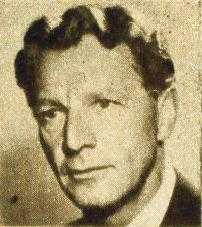Robert Barrat
| Robert Barrat | |
|---|---|
 Robert Barrat, 1938 | |
| Born |
July 10, 1889 New York City, New York USA |
| Died |
January 7, 1970 (aged 80) Hollywood, California USA |
Resting place | Green Hill Cemetery, Martinsburg, West Virginia |
| Occupation | Stage, film, television actor |
| Years active | 1915-64 |
| Spouse(s) | Mary Dean (1909 - 2001) |
Robert Harriot Barrat (10 July 1889 – 7 January 1970) was an American stage, motion picture, and television character actor.
Career
Born in New York City, Barrat made his theatrical debut in a stock company in Springfield, Massachusetts. He later acted on Broadway and went into films, acting in some one-hundred and fifty films in a Hollywood career that lasted four decades. He appeared in seven pictures with James Cagney during the 1930s. Two of his most noted roles were as the murder victim Archer Coe in Michael Curtiz's The Kennel Murder Case (1933) and as the treacherous Major Ferdinand Walsin Esterhazy in the 1937 Warner Bros. Academy Award winning film, The Life of Emile Zola. He also appeared with the Marx Brothers in Go West (1940). He played Ingrid Bergman's father in Joan of Arc (1948), though his role was so brief that when an edited version of the film was released in 1950, Barrat's role had actually been eliminated.[1] (The film has since been restored to its full length.)
He played several other historical characters as well, among them Davy Crockett in Man of Conquest, Zachary Taylor in Distant Drums, Abraham Lincoln in Trailin' West, Cornelius Van Horne in Canadian Pacific and General Douglas MacArthur in American Guerrilla in the Philippines. He was also seen as the Native American Chief Chingachgook, in the 1936 film version of The Last of the Mohicans. By 1954, he had turned to television roles. His final acting appearance was in an episode of The Alfred Hitchcock Hour in 1964.
He died of heart disease in Hollywood in 1970 and was buried at Green Hill Cemetery in Martinsburg, West Virginia.
Partial filmography
- Picture Snatcher (1933)
- Lilly Turner (1933)
- Heroes for Sale (1933)
- Baby Face (1933)
- Secret of the Blue Room (1933)
- Captured! (1933)
- Wild Boys of the Road (1933)
- The Kennel Murder Case (1933)
- Wonder Bar (1934)
- The Dragon Murder Case (1934)
- Gambling Lady (1934)
- I Am a Thief (1934)
- Upper World (1934)
- Fog Over Frisco (1934)
- Here Comes the Navy (1934)
- Housewife (1934)
- The Murder Man (1935)
- Stranded (1935)
- Devil Dogs of the Air (1935)
- Special Agent (1935)
- Dr. Socrates (1935)
- Captain Blood (1935)
- The Florentine Dagger (1935)
- The Trail of the Lonesome Pine (1936)
- Mary of Scotland (1936)
- The Last of the Mohicans (1936)
- The Charge of the Light Brigade (1936)
- The Life of Emile Zola (1937)
- Confession (1937)
- Love Is on the Air (1937)
- The Bad Man of Brimstone (1937)
- Penitentiary (1938)
- The Buccaneer (1938)
- The Texans (1938)
- Breaking the Ice (1938)
- Shadows Over Shanghai (1938)
- Charlie Chan in Honolulu (1938)
- Union Pacific (1939)
- Man of Conquest (1939)
- Allegheny Uprising (1939)
- The Man from Dakota (1940)
- Captain Caution (1940)
- Northwest Passage (1940)
- Go West (1940)
- Parachute Battalion (1941)
- Riders of the Purple Sage (1941)
- American Empire (1942)
- They Came to Blow Up America (1943)
- Bomber's Moon (1943)
- The Adventures of Mark Twain (1944)
- Dakota (1945)
- They Were Expendable (1945)
- San Antonio (1945)
- Road to Utopia (1946)
- The Sea of Grass (1947)
- Road to Rio (1947)
- I Love Trouble (1948)
- Canadian Pacific (1949)
- Davy Crockett, Indian Scout (1950) - James Lone Eagle
- American Guerrilla in the Philippines (1950)
- Flight to Mars (1951)
- Distant Drums (1951)
- Double Crossbones (1951)
- Denver and Rio Grande (1952)
References
External links
- Robert Barrat at the Internet Movie Database
- Robert Barrat at the Internet Broadway Database
- Robert Barrat at Find a Grave